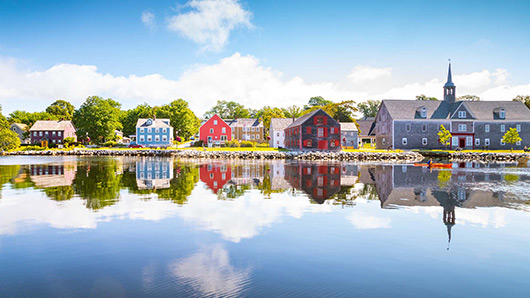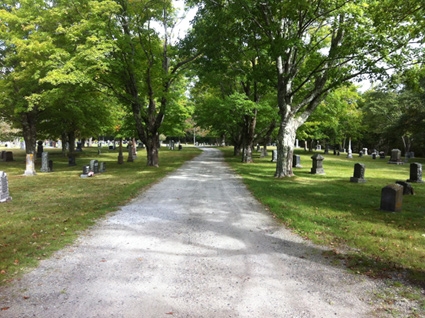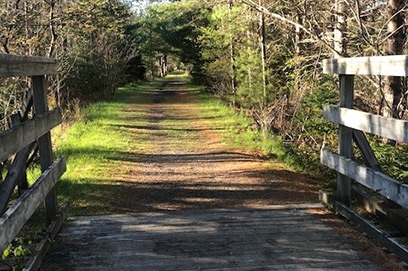Sandy point lighthouse
 The Black Loyalist Heritage Site, located in Birchtown on Nova Scotia’s South Shore, shares the story of the Black Loyalists – free men and women who fought for the British during the American Revolution and won their freedom.
The Black Loyalist Heritage Site, located in Birchtown on Nova Scotia’s South Shore, shares the story of the Black Loyalists – free men and women who fought for the British during the American Revolution and won their freedom.
In the late 18th century, Birchtown was the largest free Black community in British North America. It was the centre of the Black Loyalist experience in Canada and its founding represented a turning point in the history of persons of African descent in Canada.
In Spring 2015, the new Black Loyalist Heritage Centre opened. It takes visitors on the journey of these earliest Black settlers to Nova Scotia – and for some, back to Africa. Visitors can also trace their heritage through the names in the Book of Negroes, a document containing the names of the Black Loyalists who won their freedom by taking up arms for the British.
The original heritage site includes the National Historic Monument of Canada – located on the Black Burial Grounds – honouring the landing of the Black Loyalists in Canada in 1783; St. Paul’s Church (circa 1888); and the Old School House Museum, a one-room schoolhouse built in the 1830s and home to artifacts from archaeological digs and items donated and loaned to the museum.
You can also stroll along the Black Loyalist Heritage Trail, a 1.5 km trail with interpretive panels, which takes you to the Black Burial Ground. Site amenities include a gift shop, public washrooms, parking and a picnic area. Bus tours are welcome.

Hours
Mid October to May 31
Open Monday through Friday
9 am to 4 pm
June 1 to Mid-October
Open Daily
10 am to 5 pm
Admissions
Adult $9.20
Senior (65+) $5.75
Child (6-17) $5.75
Child (5 & under) Free
Family (max 2 adults & 3 children) $23.00
Visit the Black Loyalist Heritage Museum
Settlement of Shelburne
 Shelburne Harbour has the third-best natural harbour in the world. The native Mik'maq traversed the Roseway River and used the surrounding lands for summer encampments long before our shores were visited by Spanish, Portuguese and French fishermen.
Shelburne Harbour has the third-best natural harbour in the world. The native Mik'maq traversed the Roseway River and used the surrounding lands for summer encampments long before our shores were visited by Spanish, Portuguese and French fishermen.
In the spring of 1783, 5,000 settlers arrived on the shores of Shelburne Harbour from New York and the middle colonies of America. Assurance of living under the British flag, and promises of free land, tools, and provisions lured many to the British Colonies at that time. Four hundred families associated to form a town at Port Roseway, which Governor Parr renamed Shelburne later that year. This group became known as the Port Roseway Associates. In the fall of 1783, the second wave of settlers arrived in Shelburne. By 1784, the population of this new community is estimated to have been at least 10,000; the fourth largest in North America, much larger than either Halifax or Montreal.
In 1787, the government distribution of provisions was terminated. Within a few years, houses were put up for sale, and settlers left for England, New Brunswick, Upper Canada, and the United States. In the 1820s, the population of Shelburne had dwindled to about 300.
Although much smaller today than when it started, Shelburne remains the capital of the county which bears its name. It was incorporated as a town on April 4, 1907. The population in 2011 was 1686. Many descendants of the original Loyalists still live in the area today.
Historic Shelburne
The new town of Shelburne quickly became a fishing and shipbuilding centre. Fishing is still a primary industry today. Some other industries are lumbering, fish processing, and the manufacture of barrels, institutional furniture, granite monuments, and marine supplies.
The Black Loyalists, who settled at the same time, were allotted land on the northwest arm of Shelburne Harbour. They founded the largest free Black settlement in North America, called Birchtown, in honour of General Birch.
The area was also settled by Scottish and Irish Immigrants. In June of 1818, Welsh settlers arrived from Carmarthen and Cardigan in Wales and founded the first Welsh settlement in Canada. They settled on the west side of the Roseway River, in a community they called New Cambria. The name was later changed to Welshtown.
From the earliest times, Shelburne has been a centre for the building of ships. The first vessel launched at Shelburne was the 181 ton, Roseway, built for MacLean and Bogle in 1786. Commissary Island, now a peninsula, was the area from which supplies of flour, pork, and salt were dispensed to the Loyalists by the Commissary General, Mr. Brinley. Later, this area became the shipyard of Joseph McGill. The Cox family also built their own ships and carried on extensive world trade. The former MacKay shipyard was located in Shelburne at Black's Brook. Donald McKay, famous in the United States for the clippers which he built in Boston, began his shipbuilding career in Shelburne. He was born at Jordan Falls in 1810 and left the area at the age of 16 to apprentice in New York.
Many of Shelburne's buildings date back to Loyalist times. The Shelburne County Museum is a restored home built in 1787 by David Nairn, a cooper from Scotland. The present-day Christ Church (Anglican) is on the site of the original building of the same name which was designed by Loyalist Isaac Hildreth and consecrated by Bishop Charles Inglis in 1790. The original structure was destroyed by fire in 1971. Tottie's Store is thought to have been built by John Tottie about the year 1800.
Visitors can see dories being built using construction methods of the late 19th century at the J C Williams Dory Shop. This was officially opened in 1983 by Prince Charles and Diana, Princess of Wales.
The Ross-Thomson House and store is an authentically stocked 18th-century store and chandlery. By June of 1785, brothers George and Robert Ross, natives of Aberdeen, Scotland, conducted their business from here. The Ross brothers traded Shelburne's pine planks, codfish, ship's knees, spars, and pickled herring for salt from Turks Island, tobacco from the Carolinas and Virginia, flour from New England, rum, molasses, and sugar from the West Indies. dry goods and china from England, and wine from Madiera. Robert Thomson, the Ross brothers' clerk and accountant was from Aberdeen as well. The store was closed in the 1880s with the death of Robert Ross Thomson, son of the elder Robert Thomson. In 1931, Professor KGT Webster of Harvard University, a native of Yarmouth, purchased the house to save it from demolition.
Films
In 1992, Dock Street was the location for the filming of Mary Silliman's War, based on a true story depicting Fairfield Connecticut during the American Revolution. In 1994, Dock Street and the area was the location of a major film, "A" The Scarlet Letter, based on Nathaniel Hawthorne's novel depicting Puritan New England in the mid-1600s.

The current cemetery plot was laid out by the loyalists in 1783/1784 along with the rest of the town. Since the churches all had graveyards, Pine Grove would not be used for over 100 years. By the 1890s a decision was made to fence the area, clear and layout a number of lots. The original portion of the Cemetery is laid out in the shape of a fish. Over the years walkways and driveways were incorporated, trees planted, along with a few benches for seating.
Please look under the By-Laws and Policies section under the Town Council tab on the homepage of the website for a copy of the Pine Grove Cemetery By-Law.
pdf Cemetery By-Law 2019 (134 KB)
Contact
Daniel MacKay
Administration and Human Resource Coordinator
(902) 875-2991 ext. 8
















